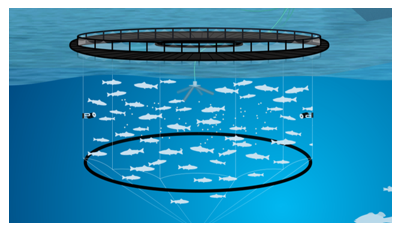INTEGRATING PRECISION AQUACULTURE STRATEGIES WITH SUBMERSIBLE PEN TECHNOLOGIES
Warm water aquaculture is expanding into open ocean areas, necessitating the submersion of aquaculture systems to avoid surface energy and warming temperatures. Specialized equipment is required to house fish, facilitate their growth, and monitor growing conditions. An integrated system of equipment and technology has been developed to address these needs. Submersible net pens can stay submerged throughout most of the grow-out cycle, allowing for a majority of the activities, from feeding to mortality removal, to be accomplished while submerged and in environments that the fish are most comfortable with. Waterborne feeding also offers many advantages, including a significant reduction in energy use and improved feed conversion ratios (FCR) due to feed pellets staying more intact. Stocking and harvesting, however, need to be done at the surface but can be scheduled around weather conditions.
Precision aquaculture is essential for the success of this system. Wireless sensors distributed throughout the site constantly measure environmental parameters such as salinity, temperature, dissolved oxygen, and other necessary data that can be viewed in real time. High-definition cameras connected to an efficient data transmission backbone allow feed managers, assisted by cutting-edge machine learning and AI algorithms, to optimize feeding regimes. Environmental data, fish behavioral data during feeding, and pellet detection provide detailed guidance for efficient feed delivery and consumption.
In addition to optimizing feeding, biomass estimations are collected and analyzed to help prescribe upcoming feeding levels and amounts and advise other managers in the company when the fish will be ready for harvest and even how much to expect. Furthermore, purchasing managers can monitor feed consumption and be ready to place orders to achieve just-in-time inventory for feed.
This fully integrated approach ensures efficient and sustainable aquaculture practices, enhanced productivity, and reduced environmental impact.
